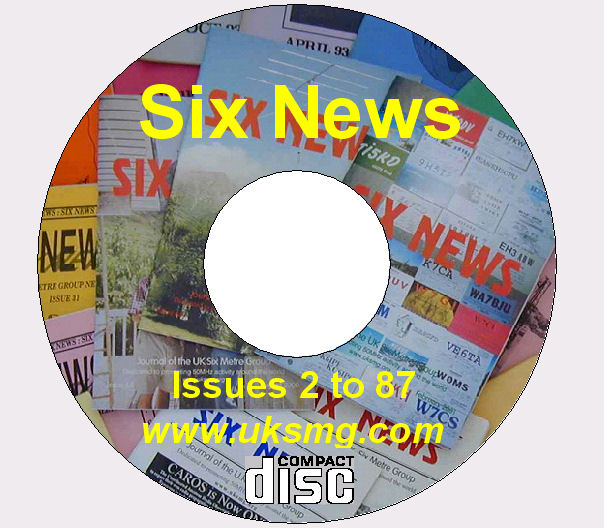

home > archive > 6m DXpeditions > the 9G5AN story

Thanks to all of our authors since 1982!
|
the
9G5AN Story |
|||
|
Arliss, W7XU/9G5XU, Ed, W0SD/9G5KW and I arrived in Accra, Ghana, on Thursday, 25th October after a long trip - 14 hours in the air. Our objective was to activate 9G on six metres, to participate in the HF DX contest, and provide a number of contacts on HF RTTY. Our first task was to pick up our licenses and we did this first thing Friday morning (with help from Ralph, 9G1RQ and Philip, 9G1PB) before heading for Elmina, about 100 miles southwest of Accra and midway to the Ivory Coast. It was mid-afternoon on Friday when we arrived at the Oyster Bay Hotel, which was to be our QTH. We began by erecting the antennas in a temperature of about 90F with humidity to match! Our first contact of the trip was at 19.42z that evening, with 9H1GB. Our six metre antenna was a seven-element K5AND design on a 27í boom with a hairpin match and 50-ohm current balun. This was supported by a 25í rotating mast turned by a Yaesu G-250 rotator and was about 50í up over water. The 28.885MHz antenna was an inverted-vee dipole, also at 50í.
Our equipment for six metres was a Yaesu FT-100D, 3CX800 amp designed and built by K5AND, Heil headsets, a Paddlette key and an Idiom memory keyer. Both the antenna/mast package and the amp weighed in at less than 30lbs each and were therefore able to be taken as carry-on baggage; this helps avoid customs issues and lost baggage! Arliss and I concentrated on six metres, generally with one operating and the other computer logging with WriteLog. This resulted in a little over 3,200 contacts in 84 countries in 8 days of operating: 2300 EU, 200 NA, 300 Asia, 200 S. America, 30 Africa and 5 Oceania. Our routine was to operate every day/night from 5:30 am until 2.00 or 3.00 am. We took off part of one morning to investigate the Castle in Elmina and a near-by rainforest; this also helped relieve fanny fatigue and cabin fever, known but seldom-fatal DXpedition hazards (not to be confused with Yellow fever, for which we had to be immunized). <pic 14 about here> Ed, W0SD operated during the CQWW contest weekend and logged over 4,500 contacts on RTTY and SSB during the contest and the remainder of the next week. He used an ICOM 746 with an Acom 1000 amp connected to a G5RV antenna. If you have never visited Ghana, you should know that the people there are very friendly. The people at the hotel were anxious to help; Ralph Quist, 9G1RQ and George Hakim, 9G1RL were invaluable with all the licensing issues. Getting through Ghana customs was hassle-free, and none of us got sick, hurt or lost weight! I should add that we had help before getting to Ghana and would to thank Mike, KC7V, Roger, G3SXW and Fred, G4BWP for their help on logistics, hotel choice, transportation and the like. Our operating highlights included long and short path contacts to JA, V73 and VR2, which were all very exciting, and may indicate some kind of record. Working 8Q7 on side-scatter to ZS was fun, as was working ZK1 by the direct path. There were incredibly strong signals from Europe and the TV blanking pulses were so strong as to QRM some of our contacts. Our best days work was 600 Qs, with the eight-day average at about 333 per day. We were able to sustain a Q rate of 140 per hour on a number of occasions.
The 9G5AN operation was fairly successful for the following reasons: excellent radio, high power and a good antenna; and having two people on the radio, one to do the computer logging and the other to operate. I honestly canít imagine sustaining the Q rates we had and trying to log manually. It also helped to have two sets of ears trying to decipher all the calls! One big surprise to us was the number of folk that did not grasp why we did not need or want grid squares in the exchange. You canít believe how much time this wastes on a DXpedition. Our repeated requests not to give locators were completely unsuccessful. The next trip we make we will attempt to do a better job publicising this. Another surprise for us was that the line voltage exceeded 300 volts several times. The average was probably 250-260, which of course made the amp happy! I guess that our only disappointments were not working any VK or ZL, and not working more US stations. With a bit of luck we will be on our travels again in 2002; the question is, where to go? Please send suggestions via e-mail.
UKSMG Six News issue 72, February 2002 |
including six-metre operation in a major DXpedition
DXpedition to Belarus Republic (EV)
the longest day at HV4NAC
the UK six metre group in Jordan
50 MHz activity from Svalbard
4L6PA - five dutch six maniacs in
Georgia
this is the 1996 CY0AA DXpedition
story
Jan Mayen on 50MHz
YM7PA - the story continues!
G0JHC, holiday with radio
('99)
8P9JO Barbados
G0JHC, Dec '99 to Jan '00
S79MX, 6m activity from Seychelles
Montserrat... still
nice... still home...
G3WOS as VP8DBL in the Falkland Islands
The VP6BR Pitcairn DXpedition
VK9WI Willis Island DXpedition
50 MHz from Greenland - the OX2K expedition
DXpedition 2000 Svalbard - JW7M
Barbados 2000
G3WOS as ZD8SIX on
Ascension
3DA0, Swaziland 2001
VK4CP/P Northern Queensland
HC8N November 2001



